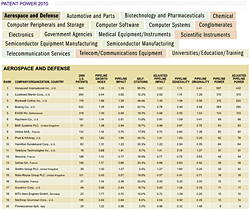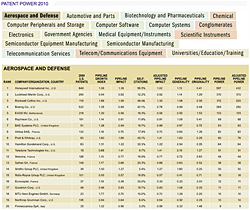Patent Power Scorecards: Japan Ascendant
Japanese companies rise to the top of IEEE Spectrum's Patent Power rankings thanks to shrinking U.S. innovation pipelines

The surprise story of this edition of the IEEE Spectrum Patent Power Scorecards is the reemergence of Japan as a global leader in innovation. Based on data from 2009, out of the 323 leading organizations in the scorecards, 65 (20 percent) are Japanese. This percentage is markedly higher than in the 2007 scorecards, in which 45 out of 319 companies (14 percent) were Japanese.
For a full explanation of how the scores are calculated, see Patent Power.
The increasing prominence of Japanese companies is particularly clear in the electronics industry. Out of the top 10 companies in the Electronics scorecard, 7 are Japanese, headed by Hitachi, Sony, and Casio. In comparison, 5 out of the top 10 electronics companies in 2007 were Japanese. Ditto for the automotive industry, where 7 of the top 10 companies in the Automotive and Parts scorecard are Japanese, compared to five in 2007. This includes 4 of the top 5 automotive companies—Honda, Toyota, Denso, and Nissan. Honda is the big mover, improving from sixth place in 2007 to top position in 2009.
Many people are familiar with Japanese cars and electronics, so the presence of Japanese companies at the top of these scorecards is not surprising. Less well known is Japan’s increasing strength in other technologies. For example, 12 of the 20 organizations in the 2009 Chemical scorecard are Japanese, compared to only 7 in 2007. Meanwhile, Japanese companies fill 2 of the top 3 places in the Semiconductor Equipment Manufacturing scorecard. Tokyo Electron has improved from No. 4 to No. 1 since 2007, while Disco Corp.—which makes laser and dicing saws for cutting semiconductor wafers—is a new entrant to the scorecard at No. 3.
If Japanese companies are the big winners in the 2009 scorecards, it is largely U.S. companies that are making way for them. The percentage of U.S. organizations in the scorecards fell from 63 percent (202 out of 319) in 2007, to 54 percent (173 out of 323) in 2009. Over the same period, the percentage of European organizations remained steady, increasing slightly from 15 percent in 2007 to 16 percent in 2009.
Clearly, the global recession seriously hampered innovation in the United States. In the last patent scorecard, based on data through 2007, we highlighted the seemingly endless rise in U.S. patent applications. The number of applications for utility patents reached a record of 456 000 in 2007, more than twice as many applications as filed in 1997, and 100 000 more than filed in 2004. Since the last scorecard, budget cuts across organizations both large and small have halted this trend. In 2008, the number of patent applications remained constant at 456 000, making it the first year since 1996 that there was not an increase in the number of applications filed.
Not only did the number of U.S. organizations in the scorecards fall by almost 30 between 2007 and 2009, some household names suffered in terms of their ranking. Xerox fell from third position in the 2007 Electronics scorecard all the way down to No. 15 in 2009. This left Microvision as the leading U.S. company in the 2009 Electronics scorecard, in thirteenth place.
Other U.S. companies to see double-digit declines in ranking include AOL (from fourth to fifteenth in Computer Software) and Micron (from third to nineteenth in Semiconductor Manufacturing). Meanwhile, leading U.S. companies that saw notable, although less dramatic, declines in ranking include General Motors (first to third in Automotive and Parts), 3M (first to sixth in Conglomerates), and Hewlett-Packard (second to fifth in Computer Systems).
The 2009 scorecards were not all bad news for U.S. companies. IBM still leads in Computer Systems by a wide margin, as does Microsoft in Computer Software. Cisco also continues to lead in Telecom/Communications Equipment and is one of three U.S. companies in the top four places in this scorecard, along with Motorola and Qualcomm.
There were also a number of U.S. companies that saw significant improvements in their ranking between 2007 and 2009. Oracle jumped from seventh to second in Computer Software, while Adobe moved from No. 12 to No. 4 in the same scorecard. Adobe has risen particularly rapidly, having entered the scorecards for the first time in 2007. Johnson & Johnson is another U.S. company that saw an improvement in ranking in 2009, rising from fourth place in Biotechnology and Pharmaceuticals to take over the top spot from Roche. KLA-Tencor is also on the rise and is now second only to Tokyo Electron in Semiconductor Equipment Manufacturing.
As large companies continue to jostle for position at the head of the scorecards, smaller specialist companies with innovative technologies are also well represented. For example, Super Talent Technology, a San Jose, Calif., company specializing in DDR (Double Data Rate) and flash memory, ranks fifth in 2009’s Computer Peripherals and Storage scorecard. This is a remarkable performance, since Super Talent’s patent portfolio is dwarfed in size by the portfolios of other companies in this scorecard, such as Seiko Epson, Ricoh, Fuji Xerox, and EMC. Super Talent’s high ranking results from a very strong combination of patent metrics, encompassing Patent Impact, Originality, and Generality.
Microvision [see In the Eye of the Beholder, May 2004 is another smaller company whose high-impact patent portfolio puts it alongside leading names in the electronics industry. Microvision develops imaging and display solutions for mobile applications. It has particularly high-impact patents related to flat-panel optical displays and nonlinear optical materials (as reflected in its high Pipeline Impact score). The impact of these patents can be seen across a range of technologies, as reflected in Microvision’s high Pipeline Generality number.
O2Micro is another company worth noting, having entered the Semiconductor Manufacturing scorecard for the first time in 2009. O2Micro specializes in power management and security ICs for electronics and communications applications. Its patent portfolio is much smaller than those of most of the companies in this scorecard, such as Samsung, Intel, and Broadcom. Despite its smaller portfolio, the impact and general applicability of O2Micro’s patents, especially those related to power supplies for LCD panels and DC/AC power converters, puts it next to the leading companies in this year’s scorecard.
Of all this year’s scorecards, none has seen bigger changes than the Universities/Education/Training scorecard. In 2007, high-profile research universities—MIT, Caltech, the University of California system, Harvard, and Rice—headed the scorecard. Out of these five universities, only the University of California is still in the top five in 2009. Caltech has dropped to eleventh, MIT to twelfth, Harvard to fifteenth, and Rice is out of the scorecard altogether. In 2009, the top five are Texas, California, Central Florida, Iowa State, and Washington, suggesting that these are emerging sources of interesting innovations. It is also notable that the 2009 scorecard contains two non-U.S. universities—the University of Oxford and South Korea’s Pohang University of Science and Technology—compared to none in 2007.
About the Authors
Patrick Thomas and Anthony Breitzman are cofounders of 1790 Analytics, LLC. The firm specializes in technology analysis and intellectual property evaluation for large corporations, government agencies, and financial institutions.
